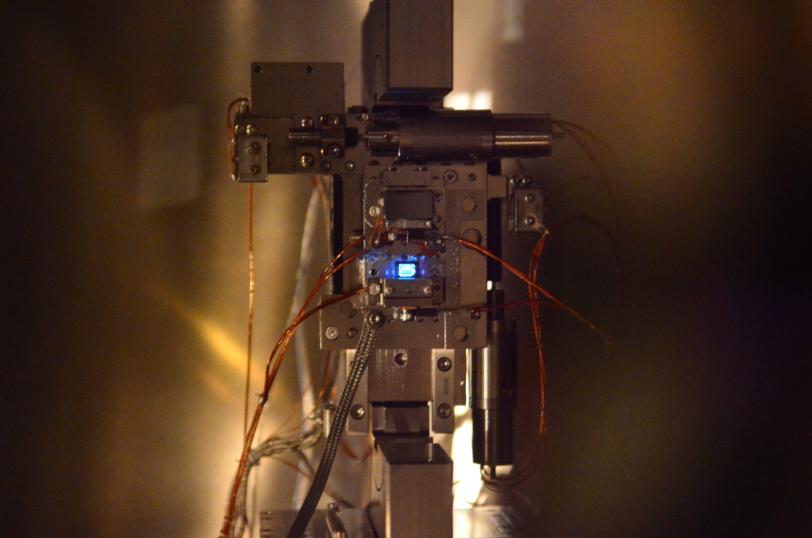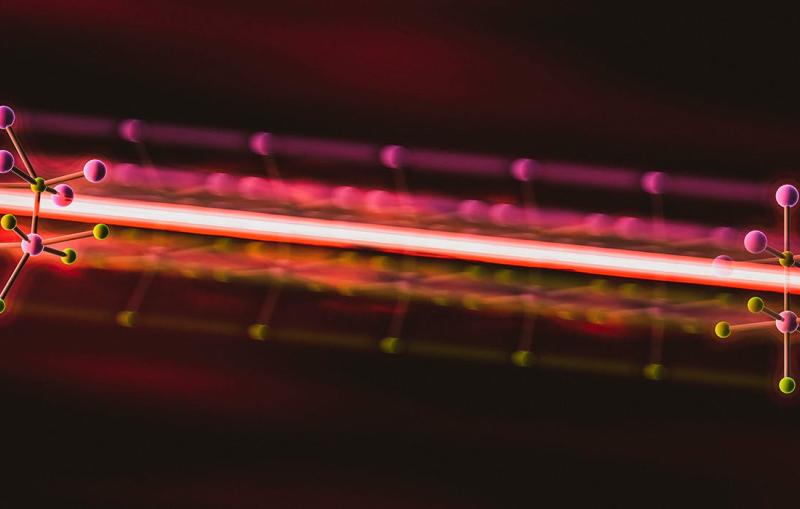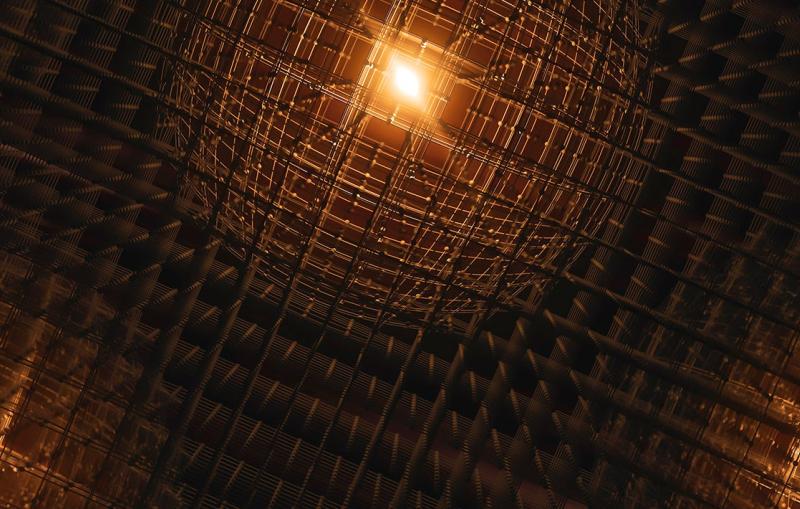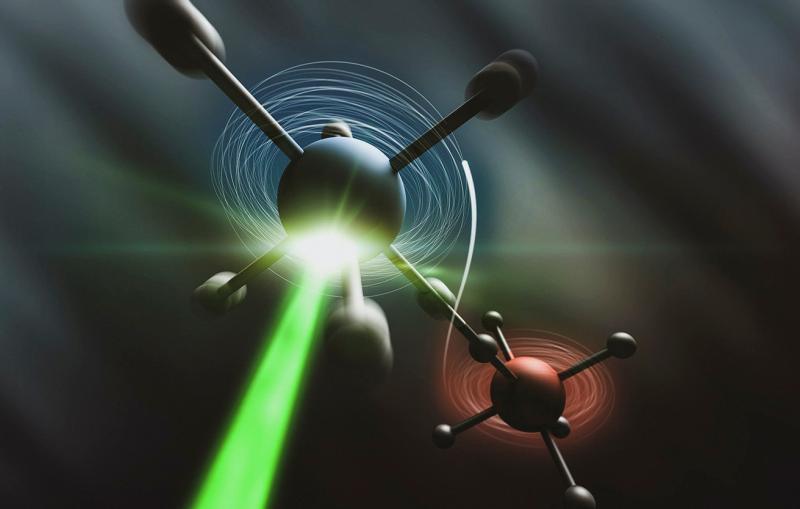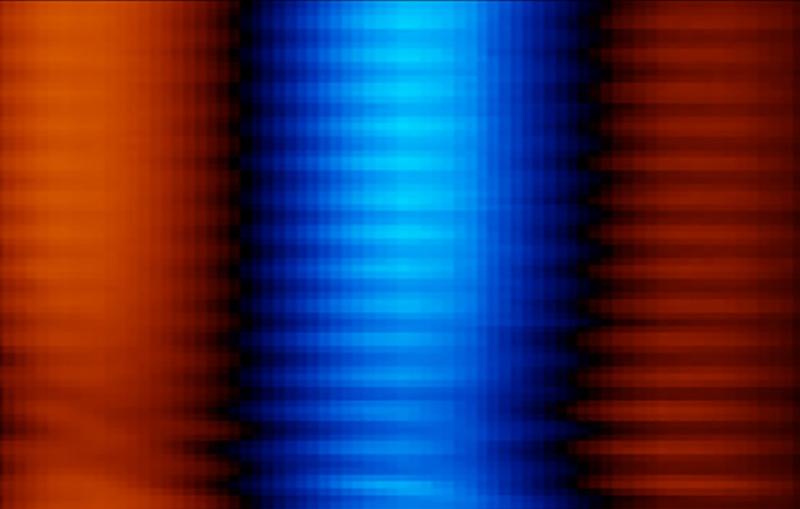'Beam Sharing': Two Experiments with One X-ray Laser
Blue-glowing diamond crystals hold promise for expanding the research capacity of SLAC's X-ray laser by divvying up its pulses for use in separate, simultaneous experiments.
By Glenn Roberts Jr.
Blue-glowing diamond crystals hold promise for expanding the research capacity of SLAC's X-ray laser by divvying up its pulses for use in separate, simultaneous experiments.
In a Feb. 6 test, scientists used perfect diamond crystals to separate ultrabright X-ray pulses at the Linac Coherent Light Source into groups of "colors," or wavelengths, for experiments spaced about 250 meters apart.
This much-anticipated feat – the result of years of work by SLAC scientists – was made possible by key contributions from researchers in three nations. The diamond crystals and their mounting hardware were crafted by the Technological Institute for Superhard and Novel Carbon Materials in Russia; taken to Argonne National Laboratory's Advanced Photon Source for intensive characterization to determine their properties; and tested at SLAC. Scientists from the Max Planck Institute for Medical Research in Germany provided samples for one of the simultaneous experiments.
"This is a long-awaited milestone, and all the scientists and institutes involved are to be congratulated on this achievement," said Jo Stöhr, LCLS director. "Last year, hard X-ray self-seeding provided our users with improved X-ray pulses, and now beam splitting will allow us to serve more users."
Although the LCLS has six experimental stations, the fact that it has only one X-ray laser beam has limited it to running only one experiment at a time. Getting time for experiments at LCLS is highly competitive, and only about one in four research proposals can be accepted.
While more work is required before LCLS can routinely offer beam sharing to scientists who use the facility, the potential to increase the volume of experiments is exciting, said Diling Zhu, an LCLS instrument scientist who has been part of the effort.
Beam sharing won't likely double the number of LCLS experiments, Zhu said, as the setup will work with only a subset of experiments that use "hard," or higher-energy, X-ray pulses. However, he said, "Even if the number of experiments increases 10 to 20 percent, that's going to be very valuable."
The Feb. 6 test delivered the majority of the X-ray laser beam's wavelengths to an experiment at LCLS's Coherent X-ray Imaging instrument to analyze the structure of lysozyme, a protein found in egg whites.
At the same time, one of the diamonds worked like a prism to filter out a narrow color band of X-ray light and direct it to the X-ray Pump-Probe (XPP) instrument. It was sufficient for conducting another set of experiments: one focusing on electrical charge in molecules of an iron-containing liquid and the other on atomic vibrations in bismuth.
All three experiments were repeats, allowing scientists to compare the beam-splitting test results with earlier results.
Yiping Feng, a SLAC staff scientist who has been working on the beam-sharing project for several years, said, "We are all very excited and happy about this demonstration. It was great teamwork." A planned X-ray laser expansion project, the LCLS-II, will allow an additional surge in the number of simultaneous experiments.
"This was definitely a first for LCLS," said Sebastien Boutet, a CXI instrument scientist, with many researchers in separate buildings coordinating their efforts in the beam-sharing design, setup and testing. Visiting scientists have been asking about progress toward beam sharing for a while, he said.
Early results suggest the quality of the data gathered in the test of simultaneous experiments is very comparable to earlier experiments, scientists said.
Slight impurities in the diamond crystals, which measure only some tenths of a millimeter in thickness, cause them to emit a brilliant blue light as X-rays pulses pass through, though this effect doesn't impact the experimental results, researchers said.
The scientists had to overcome many technical challenges to arrive at the successful diamond-crystal setup. For example, earlier tests by Feng and colleagues used silicon crystals, but the X-ray pulses caused those crystals to vibrate – a problem researchers are working to overcome. This was not an issue with the diamond crystals, whose better X-ray transparency allows for much greater thickness that reduces the vibration to completely negligible levels. Researchers hope somewhat thinner diamond crystals can be fabricated to further improve beam-sharing performance.
Future tests planned this year will explore other beam-sharing options – for example, installing an additional pair of diamond crystals in another LCLS experimental station. Scientists also hope to achieve a three-way beam split between three LCLS instruments. Another goal is to study the combination of self-seeding with beam sharing, which could more evenly split pulse energy for separate experiments.
Contact
For questions or comments, contact the SLAC Office of Communications at communications@slac.stanford.edu.
